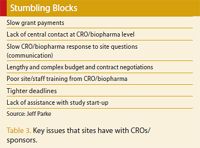Managing Customer Expectations
Applied Clinical Trials
Building a culture of service excellence between sponsor/CROs and investigative sites.

Every day we are faced with a changing biopharma industry and it inevitably impacts how CROs and other service providers interact with investigative sites/patients, as well as sponsors. All of these can be considered customers and the expectations as customers can pose a major challenge. How satisfied (or dissatisfied) customers are is determined by these expectations and a service provider's performance in meeting them.
Of course, customer satisfaction is influenced by a complex interplay of factors; it's hardly as simple as plugging numbers into a formula and calculating the result. Nevertheless, this calculation serves as a reminder that customers' level of satisfaction can be affected by changes in either their expectations or a company's overall performance. That means service providers must pay attention to both.

(ISTOCKPHOTO/THINKSTOCK)
And that's where things can get tricky, because how a service provider perceives their performance may differ from how their customers perceive it. In fact, discrepancies between a service provider's perceptions and their customers would not be at all unusual; experience has shown that most service providers routinely encounter such discrepancies.
If a service provider customer's satisfaction level is changing, find out if something has happened, either at the customer's end or at the service provider's, to affect their expectations or perceptions. Whether those changes in satisfaction level are skyward or in the direction of the bottomless pit, analyze what's happening. If satisfaction is rising, a service provider must make it a point to find out what they are doing right, so they can keep doing it; if satisfaction is slithering downward, figure out how to reverse the situation before it falls off the chart and eliminate the potential to lose business. Items a service provider should focus on "doing right" are meeting customer expectations, such as important milestones (i.e., site initiation visit (SIV) before anticipated date).
Service providers must make sure they do not get so wrapped up in delivering services that they lose sight of customers' expectations and how well they think they are being met. Be conscientious in observing what's going on in a customers' environment and how that could affect their satisfaction level. And a caution from the "we can always dream" department: don't make the mistake of concluding that if customer expectations fall, customer satisfaction will rise toward infinity. Math works that way, but customers don't.
Service providers should reach out to their customers to identify the key issues that meet customer expectations (Table 1)

Table 1. Service providers should reach out to customers to identify the key issues.
Most customers don't demand the impossible. In fact, what they want is exceedingly reasonable. And what's that? Well, switch for a moment from the service provider hat to the customer hat. When we are a customer, what matters to us? What matters when we are at the doctor's office, or participating in an oncology research study?
We all know that when we are the customer most of us want the same things: We want to be treated with respect, and we want to be listened to. We don't want to be bounced around or ignored or treated unprofessionally. We want to be fully informed about the protocol if one is the doctor, and about the treatment and any risks, or benefits from participating in a research study if we are a patient.
Now, switch back to the service provider hat and think about it: both the product and the process are important to customers. The product refers to the solution, system, response, resolution, deliverables or result. Whatever form the product takes, customers want it to work properly, to meet their needs, and to ensure that it is safe and effective.
But excelling in the technical element alone may not keep customers coming back unless service providers also attend to the processes. In fact, for many customers, the process is more important than the product. The process concerns how customers feel they've been treated. This is the human element of service and it is exceedingly important in achieving a high level of customer satisfaction.
Providing correct information may not be nearly as effective as correct information accompanied by empathy, friendliness, and respect. Focusing on the process is a way to invest in a relationship. Customers who appreciate the way they've been treated accept occasional delays and glitches without complaint. In other words, an emphasis on the human element can give us some leeway in delivering the technical element of the processes.
Investigative sites deserve to know "when:"
- When will site "x" be ready for a SIV?
- When will site "y" have an executed clinical trial agreement in place?
- When will site "z" receive payments for services performed and data submitted?
If a service provider provides quality customer support, service standards provide a formal way to communicate this information.
These service standards are expectations and managing statements used to minimize uncertainty about when some specified event will occur. The "when" may be a specific date or time, or more often, a time frame within which the event will take place. Consider these sample service standards:
- For acknowledging customers' voicemail messages: We will acknowledge messages within one business day of the call. For high priority calls, we will reply within one hour.
- For responding to service requests: We will provide written feedback on the action we will take within three days of receipt of a service request.
- For describing variations in service level: We will aim to resolve problems with products on the "A" (high priority) list within eight hours and products on the "B" (lower priority) list within one week of receiving a request for assistance.
A service provider's own time frames may differ. The issue is not the specific time frames, but whether they have established service standards and communicated them. When customers complain about poor service, it's often because of an absence of service standards that let them know what they can reasonably expect.
The preceding three standards, like most service standards, are intended to handle routine or recurring situations. But what about situations in which we don't know what the time frame will be? For example, think about the last time: a malfunction occurred that had business impact; you didn't know what caused the problem, yet; customers immediately began demanding to know when service would be restored. This is when it is vital to keep our customers informed and updated as much as possible.
Here's the lesson: When something goes awry between two parties, it's a common reaction for each to hold the other responsible. Each sees the other as having done something, or having failed to do something, that led to the unsatisfactory result. It's also not unusual for one party to find fault with the other, when the other doesn't even realize there's a problem.
More often than not, the problem is due to a miscommunication, something that's easy to avoid. In particular, when you reach an apparent understanding with someone, you need to confirm that both parties have the same understanding. Clarifying what has been agreed to helps to ensure everyone is in sync. How can we all apply these ideas in our work? Never assume that the other party has the same understanding of what has been discussed. Ask questions. Check and double-check. State your understanding and ask if you have it right. Conclude with a restatement of what everyone has agreed upon.
Regarding communication, we all want the simplest of things, such as more responsiveness, better phone manners, consistent follow-up, and most importantly, knowing whom to call with specific questions.
Building intentional working relationships
A successful service provider will lead the industry by emphasizing a customer-centric business model along with tactics that enable work groups to improve output, such as clearly defining roles, streamlining internal and external processes, and improving communication among team members. This common sense approach is most effective when it strikes a healthy balance between the cold, hard effort needed to complete a task and the softer people skills necessary to forge a committed relationship in an engaging, quality-driven work environment. Research has demonstrated that customers are happier to provide repeat business and do better work when they intentionally form solid working relationships.1 When people focus solely on the task that needs to get done and they ignore the human element, much is lost and people are less productive. Elements of an "intentional" working relationship are listed in Table 2.

Table 2. The six steps to building strong internal relationships.
For example, to improve the relationship between a service provider and their customer, service providers need to determine exactly what the customer needs. Most industry surveys report that sites want a "human element" as part of the relationship—they want to be appreciated and recognized for their hard work on increasingly complex protocols.2 They also prefer to work with a service provider that has productive, well-trained, and knowledgeable staff; use consistent protocols; set realistic patient enrollment goals; capture data proficiently; efficiently negotiate contracts, budgets, and a fair payment schedule; and maintain good communications with the site. This is a tall order, but putting processes in place to achieve at least some or all of these goals is a commitment a service provider must be willing to take.
Service providers should reach out to their customers to identify the key issues that create stumbling blocks and stall performance (Table 3).

Table 3. Key issues that sites have with CROs/sponsors.
Here's how an "intentional" relationship might work in the CRO/sponsor/site world. Working together, service providers and customers set goals to double the enrollment rate and reduce errors in case report forms (CRFs). While the service provider can supply EDC technologies to reduce errors in CRFs and introduce portals to provide study-related information, service provider's staff must become the main contact for providing training, discussing enrollment strategies, and generally communicating the sponsor's agenda of continual improvement. Essentially what the service provider must become is an ambassador for the participating sites.
Currently, conditions are ripe for the formation of these relationships. Facing a global operating environment of intense change characterized by capacity constraints, rising portfolio demands, cost containment, and depressed revenue and profitability, sponsor companies and CROs are looking to improve efficiency and performance, particularly from investigative sites. Yet, only a few organizations have announced or implemented plans and programs to support stronger site relationships.
The service provider must view customer issues with urgency, making them a priority. The service provider must take the initiative to seek solutions with a positive attitude and stay in frequent contact with the customer. Also, a true partnership means the service provider must coach the customer in ways to improve. During this process, the service provider needs to show genuine interest and empathy for what the customer experiences during the trial and become an advocate for the customer. Finally, partnering entails making sure the customer understands the performance aspects and timeline expectations (Table 4).

Table 4. Steps to implementing productive CRO/sponsor/site alliances.
Strong working relationships among service providers and customers provide the backbone to start studies on time, raise recruitment rates and make sure both parties are on the same page. By opening up these lines of communication, the biopharma industry can expect to experience a positive shift in streamlined contractual and regulatory processes that will inevitably lead to the production of timely and quality study data as well as faster drug development. Essentially, when customers and service providers are working with the same goals in mind—to begin working on a study as quickly as possible—one can expect to see more projected timelines being met and more studies being initiated, the advancement of medicine, and greater patient care.
Building customer confidence
A service provider's most precious asset is its customers' confidence in the service that is rendered. To secure a clear direction for its efforts, departmental heads must create a vision to ensure that they build a culture of service excellence and mutual respect to facilitate service to investigative sites, patients, and families.
The strategic plan to achieve this vision includes dimensions focused on both people and the supporting systems of care. The ultimate goal is to create an ideal environment for service excellence. Such an environment must be innovative, proactive, accountable, and emphasize mutual respect and communication. The ability to provide great service to patients is what separates the best companies from the ones that lack a clear vision.
The key strategic goals in pursuit of the vision are outlined in this article. The specific objectives and operational strategies must be designed and implemented by a successful CRO or biopharma company.
Goal 1: engage sites. The leading edge of a service provider's approach to excellence will be visible in the service they provide to their customers, be it an investigative site or the doctors and patients they work with on a daily basis. An outstanding healthcare experience for the investigative site and the patient population requires excellence from any service provider. Collectively both service providers as well as customers know that the most important driver of a successful study is the sponsor/CRO/site relationship. As a whole, any service provider must heavily focus on ensuring that tight deadlines are met and that impeccable customer service is provided to the customer. Customers must know that they are important and that the services provided to the community and medicine as a whole is appreciated.
Goal 2: analyze and recommend service metrics and measurement processes. The key elements to any service provider's successes is a clearly articulated vision for service excellence, the passionate support of the organization, and a well-developed action plan to meet goals and metrics. For any service provider, to sustain its efforts in service excellence, there must be strong leadership support and principles of excellence should be evident in the organization's culture. Finally, service excellence must be integrated into the organization's strategic plan, operational plan, and measures of performance.
Jeff Parke is Associate Site Start-Up Team Lead, Regulatory & Start-Up at Quintiles, 4820 Emperor Blvd., Durham, NC, e-mail: jeff.parke@quintiles.com.
References
1. Lang, D. Paravincini, Y. Pigneur, E. Rivaz, " From Customer Relationship Management to Supplier Relationship Management, " HEC Lausanne University of Lausanne 2002
2. B. Harper, "The Effectiveness of Sponsor/CRO-Site Performance Incentives", The Monitor, Fall 2005

FDA-Approved Gene Therapy Beqvez Shows Sustained Efficacy, Safety in Long-Term Hemophilia B Trial
April 17th 2025Beqvez (fidanacogene elaparvovec), an FDA-approved one-time gene therapy for hemophilia B, demonstrated sustained factor IX expression, low bleeding rates, and a favorable safety profile over long-term follow-up.
Improving Relationships and Diversifying the Site Selection Process
April 17th 2025In this episode of the Applied Clinical Trials Podcast, Liz Beatty, co-founder and chief strategy officer, Inato, discusses a number of topics around site engagement including community-based sites, the role of technology in improving site/sponsor relationships, how increased operational costs are impacting the industry, and more.
Behind the Buzz: Why Clinical Research Leaders Flock to SCOPE Summit
February 7th 2025In this episode, we meet with Micah Lieberman, Executive Conference Director for SCOPE Summit (Summit for Clinical Ops Executives) at Cambridge Innovation Institute. We will dive deep into the critical role of collaboration within the clinical research ecosystem. How do we bring together diverse stakeholders—sponsors, CROs, clinical trial tech innovators, suppliers, patients, sites, advocacy organizations, investors, and non-profits—to share best practices in trial design, program planning, innovation, and clinical operations? We’ll explore why it’s vital for thought leaders to step beyond their own organizations and learn from others, exchanging ideas that drive advancements in clinical research. Additionally, we’ll discuss the pivotal role of scientific conferences like SCOPE Summit in fostering these essential connections and collaborations, helping shape the future of clinical trials. Join us as we uncover how collective wisdom and cross-industry partnerships are transforming the landscape of clinical research.